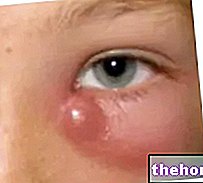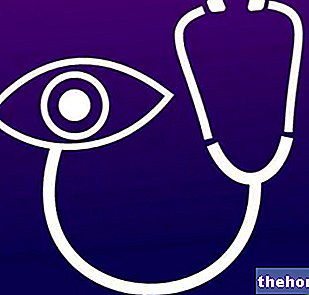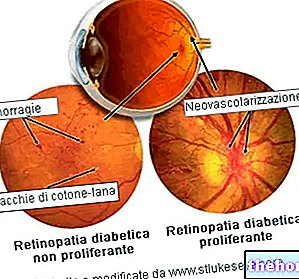Generality
Photophobia is an "abnormal intolerance to light, whereby exposure to it causes eye discomfort or pain with repeated eyelid twitching and other reactions aimed at avoiding light.

Symptoms
Photophobia can be associated with different symptoms, which depend on the underlying cause. Some people are sensitive only to very intense light, while in severe cases considerable pain can arise from exposure to any light source (sunlight or artificial light, candle flames or fires).
Some obvious symptoms allow you to recognize if the sensitivity to light has increased, such as:
- Moderate or severe eye pain, even in low light conditions
- Need to close your eyes
- Burning in the eyes;
- Excessive tearing.
In some cases, in addition to photophobia, there are no further manifestations; in others, however, people have many symptoms. This depends on the disease causing the photophobia.
If the intolerance to light is severe, has persisted for more than two days and the pain in the eyes is extremely intense, it is advisable to consult an ophthalmologist. Other signs, which highlight the presence of a problem that requires medical attention, are:
- Headache and / or migraine;
- Vertigo and nausea;
- Stiffness in the neck;
- Blurred vision, diplopia and / or distorted vision;
- Redness of the eyeball and eyelids;
- Pain, itching and irritation of the eyes, eyelids and conjunctiva;
- Numbness or tingling in other parts of the body
- Change in hearing (example: phonophobia).
Causes
Photophobia can be caused by:
- Excessively intense light. An excessive amount of light can enter the eye if it is damaged, such as in the case of injury to the cornea or damage to the retina. This effect is also found when the pupil is unable to react normally to a light stimulus (for example, due to damage to the oculomotor nerve).
- Albinism. Albinism is an inherited condition characterized by melanin pigmentation deficiency in the skin, iris, choroid, hair and hair. In particular, the absence of pigment makes the iris somewhat translucent, exposing the subject to greater sensitivity (it cannot completely block the light that thus penetrates the eye).
- Medicines. Some medications can cause light sensitivity as a side effect, including scopolamine, atropine, furosemide, quinine, tetracycline, and doxycycline. Mydriasis, ie pupil dilation, can also be caused by the intake of cocaine and amphetamines.
- Light eyes. A person's eye color can also influence the appearance of symptoms. People with lighter colored eyes may experience different levels of sensitivity to light than people with dark eyes. It is believed that photophobia may be due to the reduced amount of melanin, which confers less protection against sunlight.
Patients can develop photophobia as a result of various medical conditions relating to the eye or nervous system. The main eye diseases related to photophobia are:
- Cataract;
- Coloboma;
- Viral conjunctivitis;
- Corneal abrasion, dystrophy and ulcer;
- Keratitis;
- Congenital anomalies of the eye;
- Eye trauma caused by disease, injury or infection such as chalazion, episcleritis, glaucoma and keratoconus;
- Iritis and uveitis;
- Optic neuritis;
- Pupillary dilation (natural or induced);
- Detachment of the retina;
- Scarring of the cornea or sclera.
Conditions that affect the nervous system and manifest with photophobia are:
- Encephalitis;
- Meningitis;
- Subarachnoid hemorrhage
- Some brain tumors
Other causes that can induce photophobia include:
- Ankylosing spondylitis;
- Benzodiazepines (prolonged use or withdrawal);
- Chemotherapy;
- Influence;
- Infectious mononucleosis;
- Vitamin B2 deficiency;
- Magnesium deficiency;
- Cluster headache and migraine;
- Botulism;
- Anger;
- Mercury poisoning;
- After-effects of alcohol abuse.
Treatment
The best way to alleviate the discomfort associated with photophobia is to "address the underlying cause. In many cases, when the condition that triggers the symptoms is treated correctly, the sensitivity levels decrease and the photophobia disappears. For example, if the problem is. caused by taking a drug, the patient can contact their doctor to evaluate the suspension or replacement of therapy.
The discomfort caused by sensitivity to light can be reduced by taking the following measures:
- Avoid sunlight and strong light sources;
- Wear wide-brimmed hats and sunglasses (with UV protection);
- Darken the room.
Photochromic lenses are another solution for excessive sensitivity to the sun: they automatically darken outdoors, protecting the eye from UV rays and solar glare. Even sunglasses with polarized lenses offer protection against glare caused by light reflections from sand, water, snow, concrete roads and other reflective surfaces. In extreme cases, special prosthetic contact lenses can be worn. able to reduce the amount of light entering the eye and make the stay in bright environments more comfortable.




























